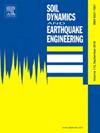考虑减振垫动粘弹性的车轨耦合系统振动能量传递特性
IF 4.2
2区 工程技术
Q1 ENGINEERING, GEOLOGICAL
引用次数: 0
摘要
安装减振垫是中国高速铁路板式轨道的主要减振措施。本文研究了这些垫块的动态粘弹性对车辆-轨道振动能量传递的影响。将分数阶导数模型与广义Maxwell模型相结合,建立了车辆-轨道耦合动力学模型。采用功率流法,定量分析了减振垫的安装、温度和频率相关特性以及列车速度对轨道振动能量传递的影响。结果表明,忽略减振垫的频率特性降低了复合材料与基板之间的能量传递,从而高估了减振垫的减振效果。环境温度的降低降低了复合板的振动能,而增加了基层的振动能。较高的列车速度使轨道结构的振动能量峰值向更高的频率偏移。因此,在高速铁路减振轨道的设计和运行中,应考虑减振垫层的温度和频率相关粘弹性。本文章由计算机程序翻译,如有差异,请以英文原文为准。
Vibration energy transmission characteristics of vehicle-track coupled system considering dynamic viscoelasticity of vibration-damping pads
The installation of vibration-damping pads is the primary vibration reduction measure for slab tracks of high-speed railways in China. This study examines how the dynamic viscoelasticity of these pads influences vehicle-track vibration energy transmission. The viscoelasticity was characterized by combining the fractional derivative model and generalized Maxwell model, which were incorporated into a vehicle-track coupled dynamics model. Using the power flow method, the effects of vibration-damping pad installation, temperature- and frequency-dependent properties, and train speed on track vibration energy transmission were quantitatively analyzed. The results indicate that the neglecting frequency-dependent characteristics of the vibration-damping pads reduces energy transmission between the composite and base slabs, thereby overestimating the vibration reduction effect of the vibration-damping pads. A decrease in ambient temperature reduces vibration energy in the composite slab while increasing it in the base slab. Higher train speeds shift the vibration energy peak of the track structure to higher frequencies. Therefore, the temperature- and frequency-dependent viscoelasticity of the vibration-damping pads should be considered in the design and operation of vibration-damped tracks for high-speed railways.
求助全文
通过发布文献求助,成功后即可免费获取论文全文。
去求助
来源期刊

Soil Dynamics and Earthquake Engineering
工程技术-地球科学综合
CiteScore
7.50
自引率
15.00%
发文量
446
审稿时长
8 months
期刊介绍:
The journal aims to encourage and enhance the role of mechanics and other disciplines as they relate to earthquake engineering by providing opportunities for the publication of the work of applied mathematicians, engineers and other applied scientists involved in solving problems closely related to the field of earthquake engineering and geotechnical earthquake engineering.
Emphasis is placed on new concepts and techniques, but case histories will also be published if they enhance the presentation and understanding of new technical concepts.
 求助内容:
求助内容: 应助结果提醒方式:
应助结果提醒方式:


